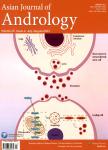Cr(V)involvementin the toxicity pathway of testicular damage
作者机构:DepartmentofBiology DepartmentofchemistryUniversityofAveriro3810-193AveiroPortugal
出 版 物:《Asian Journal of Andrology》 (亚洲男性学杂志(英文版))
年 卷 期:2002年第4卷第2期
页 面:153-155页
核心收录:
学科分类:1002[医学-临床医学] 100210[医学-外科学(含:普外、骨外、泌尿外、胸心外、神外、整形、烧伤、野战外)] 10[医学]
主 题:Blood-testis barrier Cr(V) Horseradish peroxidase Integrity Spermatogenesis
摘 要:OBJECTIVE:The functional integrity of the blood-testis barrier (BTB) in male mice exposed to Cr(V) was studied in order to clarify the mechanism underlying testicular injury.;METHODS:Adult male mice were subcutaneously injected repeated doses of 8.02 micromol (0.5 ml) of Cr/*** for 5 days. Animals receiving a similar volume of bis(hydroxyethyl)-aminotris(hydroxymethyl)methane buffer (BT) were used as controls. The animals were sacrificed on day 6 and small fragments of seminiferous tubules, approximately 8-10 mm length, were incised and sutured at both ends. They were exposed in vitro to horseradish peroxidase-containing culture medium for 10 minutes. Tissues were then fixed and processed for ultrastructural studies.;RESULTS:Controls and Cr(V)-treated group resulted in the uptake of the tracer by Sertoli cells. However, the major finding consisted in the permeability of the BTB only in the Cr(V)-group, as evidenced by the presence of the tracer within the junctions between the neighbouring Sertoli cells.;CONCLUSIONS:The BTB is disrupted in mice submitted to Cr(V). The permeability of the BTB is a crucial feature to be investigated for the understanding of lesions within the seminiferous tubule.



